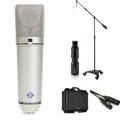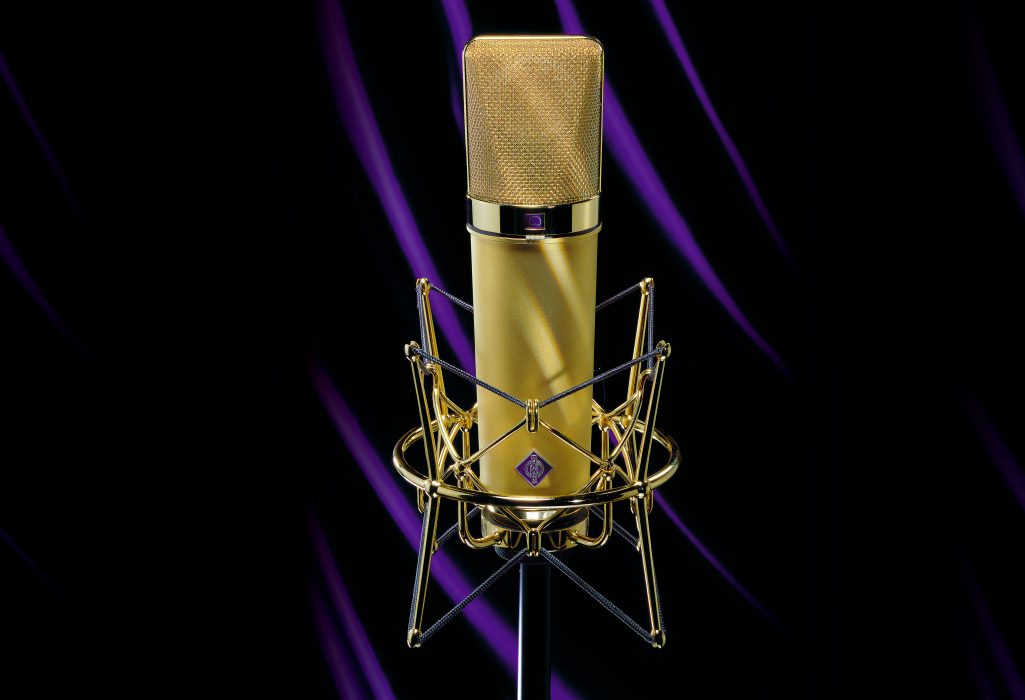
The industry-standard large-diaphragm condenser mic
In the 1960s, the new transistor was making serious inroads into the tube-driven world of pro audio. In 1967, Neumann’s large-diaphragm U 67 tube condenser microphone, which the company had introduced in 1960, was replaced by the solid-state U 87, which sported modern FET (Field Effect Transistor) circuitry and could be powered by phantom power rather than requiring a separate power supply for each mic. Engineers, producers, and their clients loved the U 87, and by the mid 1970s it was an industry standard found in every world-class recording studio. And it still is.
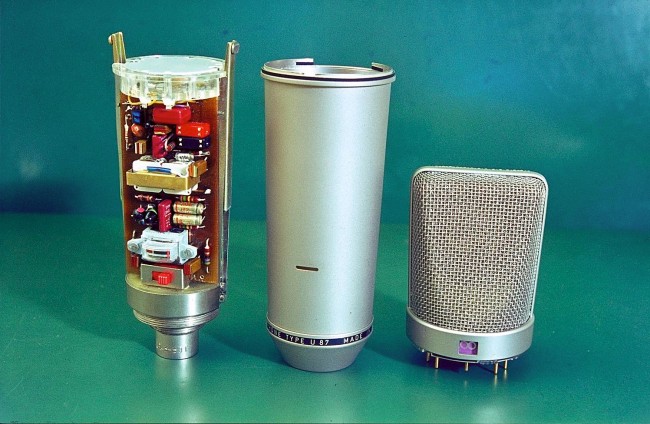
Early U 87 showing detachable headbasket
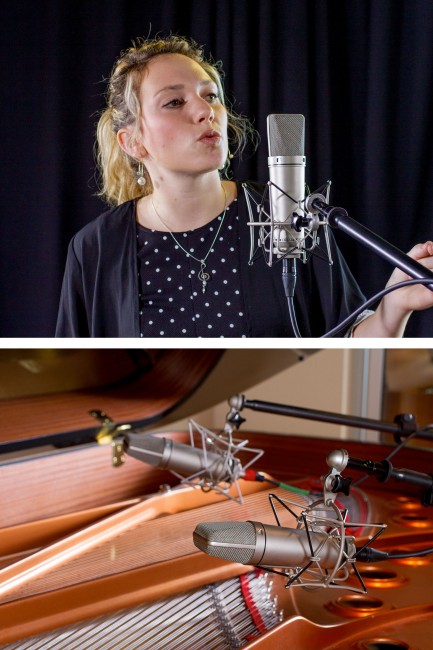 Walk into a session, and you would see 87s everywhere. On piano, vocals, toms, overheads, guitar cabs, brass, strings, congas – you name it. The 87’s popularity is easy to understand: not only did the mic usher in a new era of audio fidelity and reliability, but with three selectable polar patterns (cardioid, omnidirectional, and figure-8), plus a switchable highpass filter and 10dB pre-attenuation pad, the U 87 is incredibly versatile and an ideal choice for a range of recording techniques.
Walk into a session, and you would see 87s everywhere. On piano, vocals, toms, overheads, guitar cabs, brass, strings, congas – you name it. The 87’s popularity is easy to understand: not only did the mic usher in a new era of audio fidelity and reliability, but with three selectable polar patterns (cardioid, omnidirectional, and figure-8), plus a switchable highpass filter and 10dB pre-attenuation pad, the U 87 is incredibly versatile and an ideal choice for a range of recording techniques.
“The U 87 is a great choice for any source”
When you’re striving for fidelity, clarity, and authoritative presence, the U 87 – with its ruler-flat midrange and gentle presence boost – is your go-to mic. We all need vocals to shine in the mix, and the U 87 was created for this. You will find it was and still is the vocal microphone of choice on innumerable iconic recordings. Piano? Grand or upright, when you need an acoustic piano to sit pretty in a thick track, a couple of 87s will get the job done.
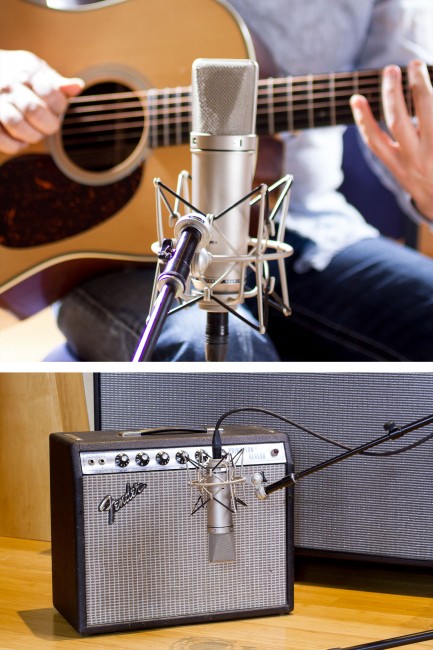 On acoustic guitar, aim an 87 down at the 12th fret from about 14 inches away, and you’re ready to record. On electric guitar cabinets, the U 87 is a perfect on-cabinet or room-mic choice. Countless hit records feature guitar parts recorded with a dynamic or ribbon (or both) relatively close to the speaker grille, and one or more 87s further away. Pointing it at the center of the cone at a distance of 12-18″ is the preference of some engineers like Ken Scott whose engineering credits include guitar luminaries like George Harrison, Jeff Beck and Steve Morse. If you want a live acoustic ambience in the sound, positioning the guitar cabinet in a stairwell or bathroom can make an effective live echo chamber. Again, the U 87 won’t let you down and will capture the live acoustics accurately. As always, experimentation with polar patterns and mic positioning in the room can deliver unexpected sonic rewards.
On acoustic guitar, aim an 87 down at the 12th fret from about 14 inches away, and you’re ready to record. On electric guitar cabinets, the U 87 is a perfect on-cabinet or room-mic choice. Countless hit records feature guitar parts recorded with a dynamic or ribbon (or both) relatively close to the speaker grille, and one or more 87s further away. Pointing it at the center of the cone at a distance of 12-18″ is the preference of some engineers like Ken Scott whose engineering credits include guitar luminaries like George Harrison, Jeff Beck and Steve Morse. If you want a live acoustic ambience in the sound, positioning the guitar cabinet in a stairwell or bathroom can make an effective live echo chamber. Again, the U 87 won’t let you down and will capture the live acoustics accurately. As always, experimentation with polar patterns and mic positioning in the room can deliver unexpected sonic rewards.
Let’s talk about miking drums. If you’ve got space in the mix for gargantuan toms with massive impact, close-miking each drum with a cardioid U 87 will do the trick. Not too close though – you want the drums to breathe, and you don’t want the drummer hitting the mics! Used for overheads, a pair of 87s offer the cutting power you’ll need for a focused stereo image that holds its own in an aggressive rock or metal track. We’ve even used them on kick drums (just be sure to engage the 10dB pad).
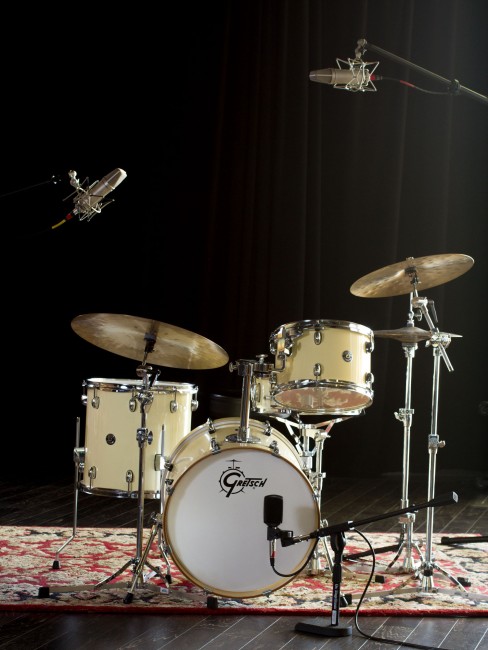 The Neumann U 87 is fabulous on percussion, from congas, cajon, tambourine, and shaker to mallet instruments such as vibraphone, marimba, glockenspiel, tympani, gongs, chimes, celesta, and even concert snare and bass drums. Since we’ve ventured into classical territory here, we should point out that the 87 is an ideal microphone for all orchestral instruments – solo and ensemble – and an excellent choice for spot mics on string, brass, and woodwind sections. In fact, you could record a full-size symphony orchestra with nothing but U 87s. We’ve done it.
The Neumann U 87 is fabulous on percussion, from congas, cajon, tambourine, and shaker to mallet instruments such as vibraphone, marimba, glockenspiel, tympani, gongs, chimes, celesta, and even concert snare and bass drums. Since we’ve ventured into classical territory here, we should point out that the 87 is an ideal microphone for all orchestral instruments – solo and ensemble – and an excellent choice for spot mics on string, brass, and woodwind sections. In fact, you could record a full-size symphony orchestra with nothing but U 87s. We’ve done it.
Which leads us to jazz – and the saxophone: the U 87 is an ideal mic for any instrument in the sax family. Here’s an effective technique for recording a sax solo with natural slap echo: position a U 87 (on figure-8) between the sax player and the control room window; adjust overall distance and mic position to taste. Note that you will be married to the effect, but in many situations the results will be well worth it. You can also use a figure-8 technique to record two singers on one mic (again, be sure of the balance – you own it).
“The perfect mic for an infinite variety of recording techniques”
The U 87’s three polar patterns give you impressive flexibility when it comes to exploring different recording techniques. With two 87s, you can implement stereo techniques such as spaced pair (A/B), X-Y (including Blumlein), ORTF array, and mid-side (M-S). For full orchestra, add a third 87 for the minimalist – and highly effective – Mercury Living Presence technique: three spaced omni 87s across the orchestral soundstage, centered above the conductor’s podium. Record to three tracks panned left-center-right. Set your mic levels for peaks, then leave those level-matched faders alone and let the conductor balance the orchestra. If you find you need spot mics to fill in, the U 87 is, again, a great choice.
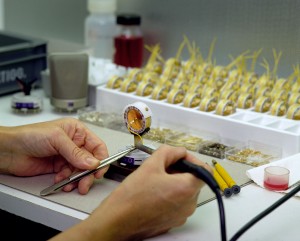
“Neumann microphones are not assembly-line products”
In 1928, Georg Neumann founded the company that bears his name and introduced the first mass-produced condenser microphone, the CMV 3, a.k.a. the Neumann Bottle. Ever since, the Neumann badge has stood for unwavering quality. Neumann’s instantly recognizable diamond is more than a corporate logo – it is a quality seal. Every microphone that bears the Neumann logo is a testament to this proud tradition. This level of excellence requires rigorous quality control to maintain Neumann’s status as a leading manufacturer of studio microphones. Neumanns are not assembly-line products; they’re handcrafted in Germany by highly skilled technicians.
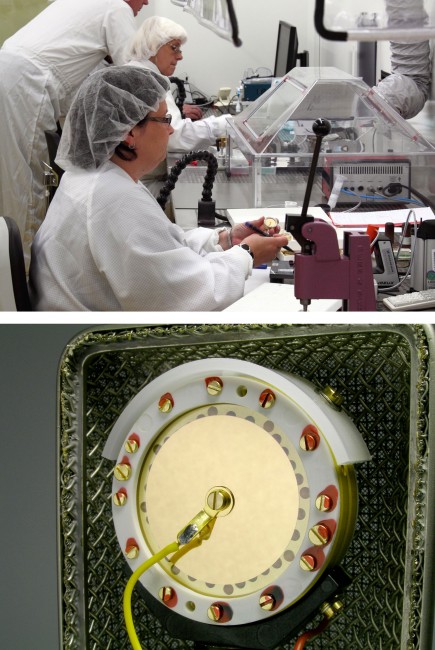 The distance between membrane and electrode of a mic capsule is 35 microns – less than the width of a human hair. The layer of gold applied to a capsule diaphragm is just 0.03 microns thick, equivalent to 208 atoms of gold. Even minute levels of contamination can adversely affect sonic characteristics – which is why Neumann mics are assembled in a state-of-the-art clean room with monitored dust levels under 100 particles per cubic foot – demanding conditions on par with the production of semiconductor chips and heart catheters.
The distance between membrane and electrode of a mic capsule is 35 microns – less than the width of a human hair. The layer of gold applied to a capsule diaphragm is just 0.03 microns thick, equivalent to 208 atoms of gold. Even minute levels of contamination can adversely affect sonic characteristics – which is why Neumann mics are assembled in a state-of-the-art clean room with monitored dust levels under 100 particles per cubic foot – demanding conditions on par with the production of semiconductor chips and heart catheters.
But it’s not enough to build one great mic; the real trick is to be able to manufacture multiple units that all sound identical. To this end, Neumann sets the tolerances of each Neumann mic to the minimum possible variance as compared with an equivalent Neumann product. This is what some mic manufacturers do with matched pairs – but Neumann does it for all their microphones. So when you use two 87s to capture an accurate stereo image, you can do so with confidence.
“One thing top studios’ mic lockers have in common is the venerable Neumann U 87”
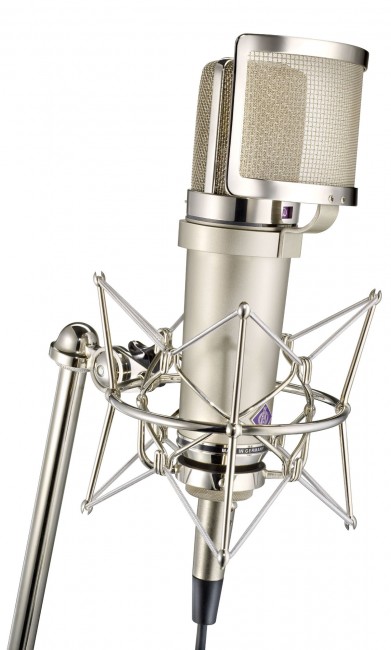 When clients come into your studio, appearances matter – and having no-name microphones set up in your tracking room will not impress them. If your clients see a Neumann, they’ll know they’re dealing with a professional studio – a place that values iconic tools of the recording trade. The Neumann U 87 commands instant respect and has been the industry-standard large-diaphragm condenser mic for decades; it’s arguably the most widely recognized and respected condenser mic of all time. So when you’re ready for a mic that proclaims that you and your studio have arrived, then you’re ready for Neumann. So call your Sweetwater Sales Engineer today and get a U 87 or other Neumann that’s right for you, because Sweetwater is your source for Neumann microphones.
When clients come into your studio, appearances matter – and having no-name microphones set up in your tracking room will not impress them. If your clients see a Neumann, they’ll know they’re dealing with a professional studio – a place that values iconic tools of the recording trade. The Neumann U 87 commands instant respect and has been the industry-standard large-diaphragm condenser mic for decades; it’s arguably the most widely recognized and respected condenser mic of all time. So when you’re ready for a mic that proclaims that you and your studio have arrived, then you’re ready for Neumann. So call your Sweetwater Sales Engineer today and get a U 87 or other Neumann that’s right for you, because Sweetwater is your source for Neumann microphones.
Thanks to our friends at Neumann for their help with images and info for this article. To find out more about Neumann mics, check out our Neumann Microphones Buying Guide.


